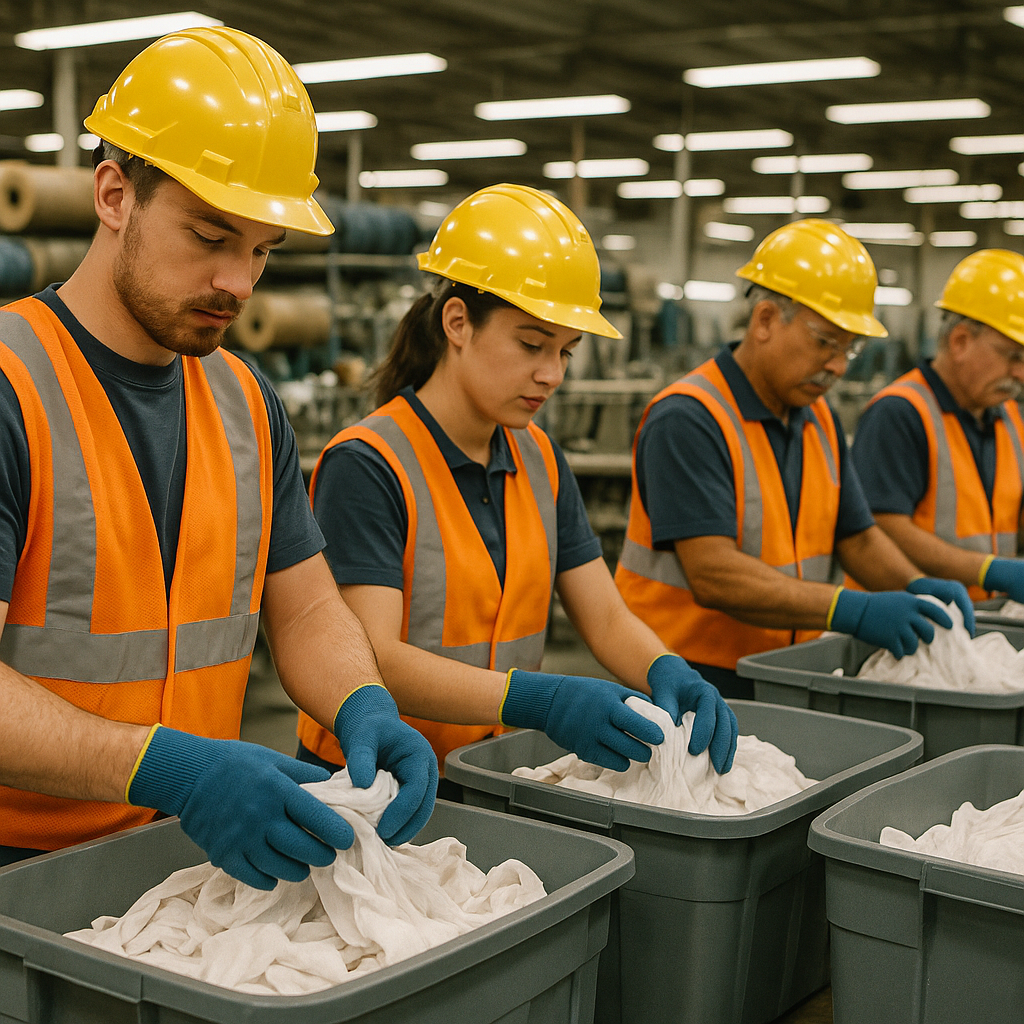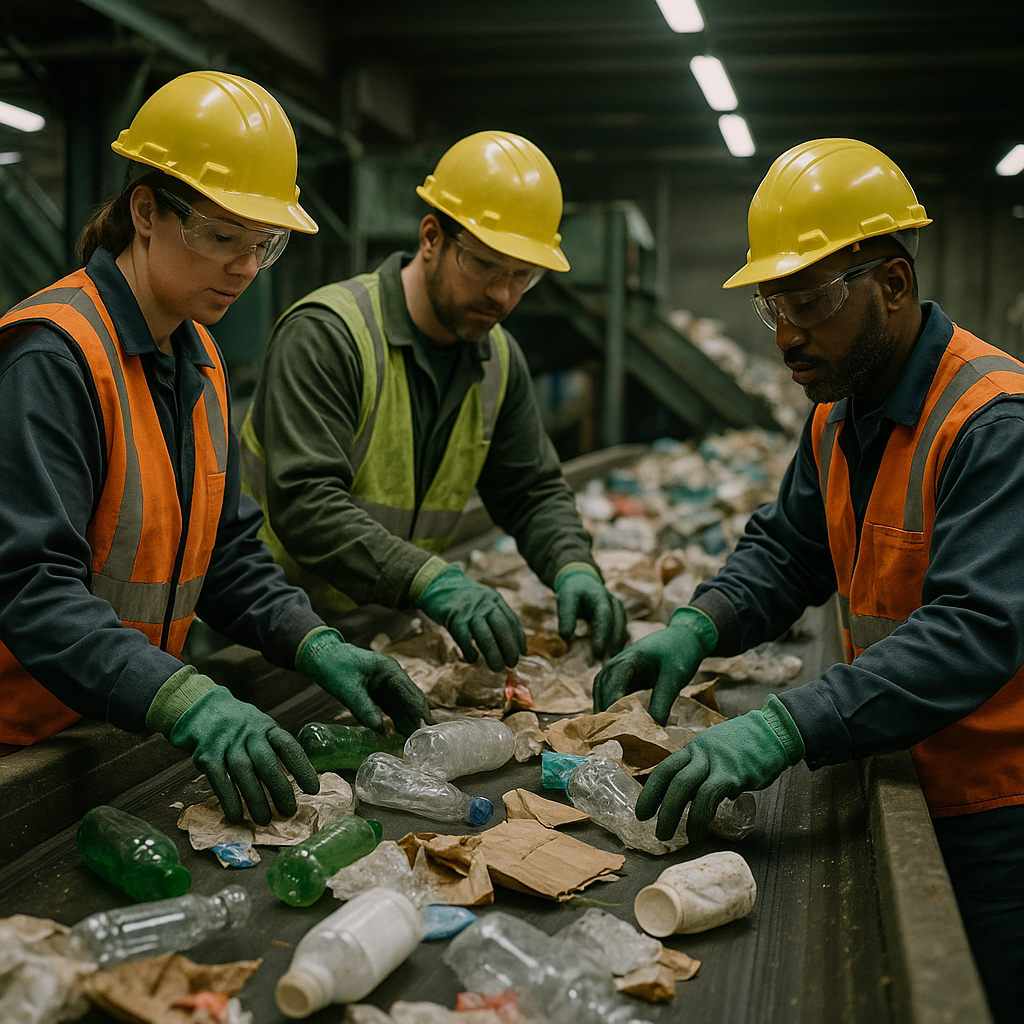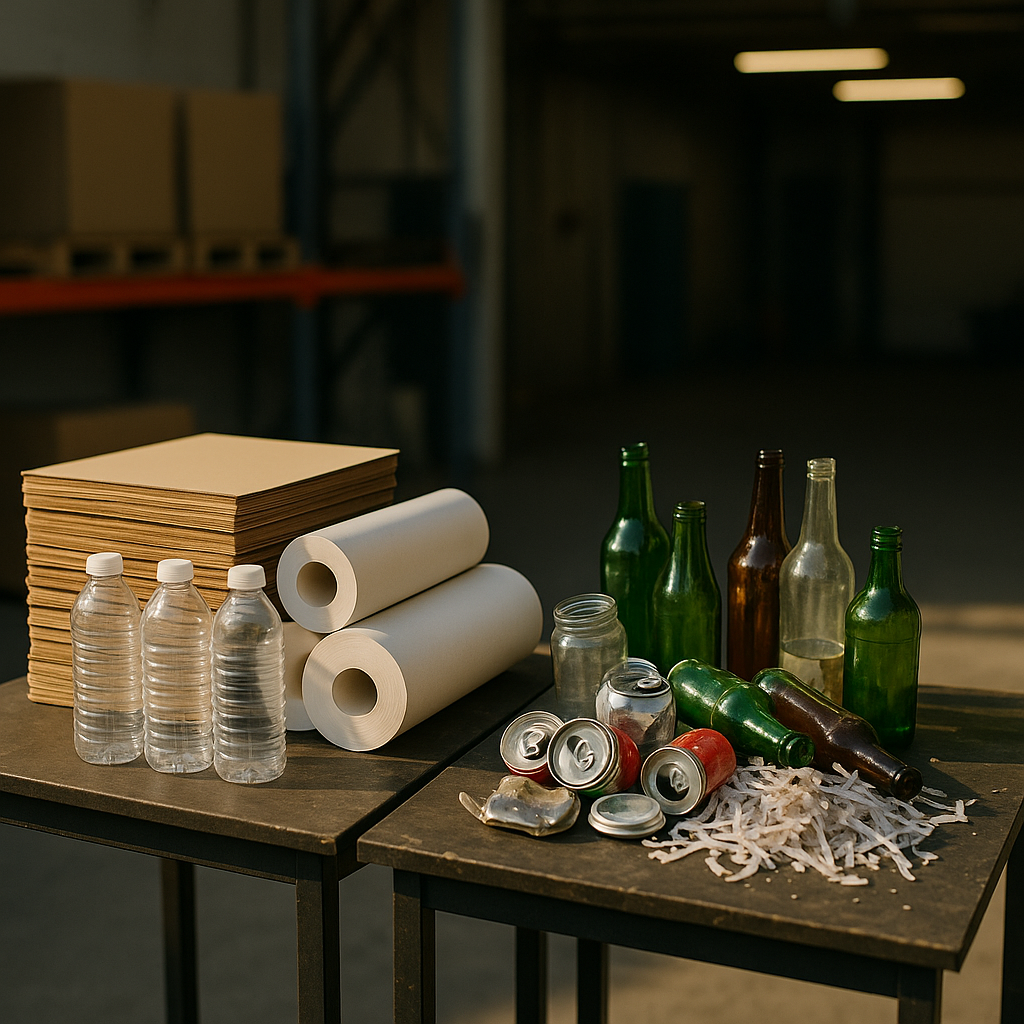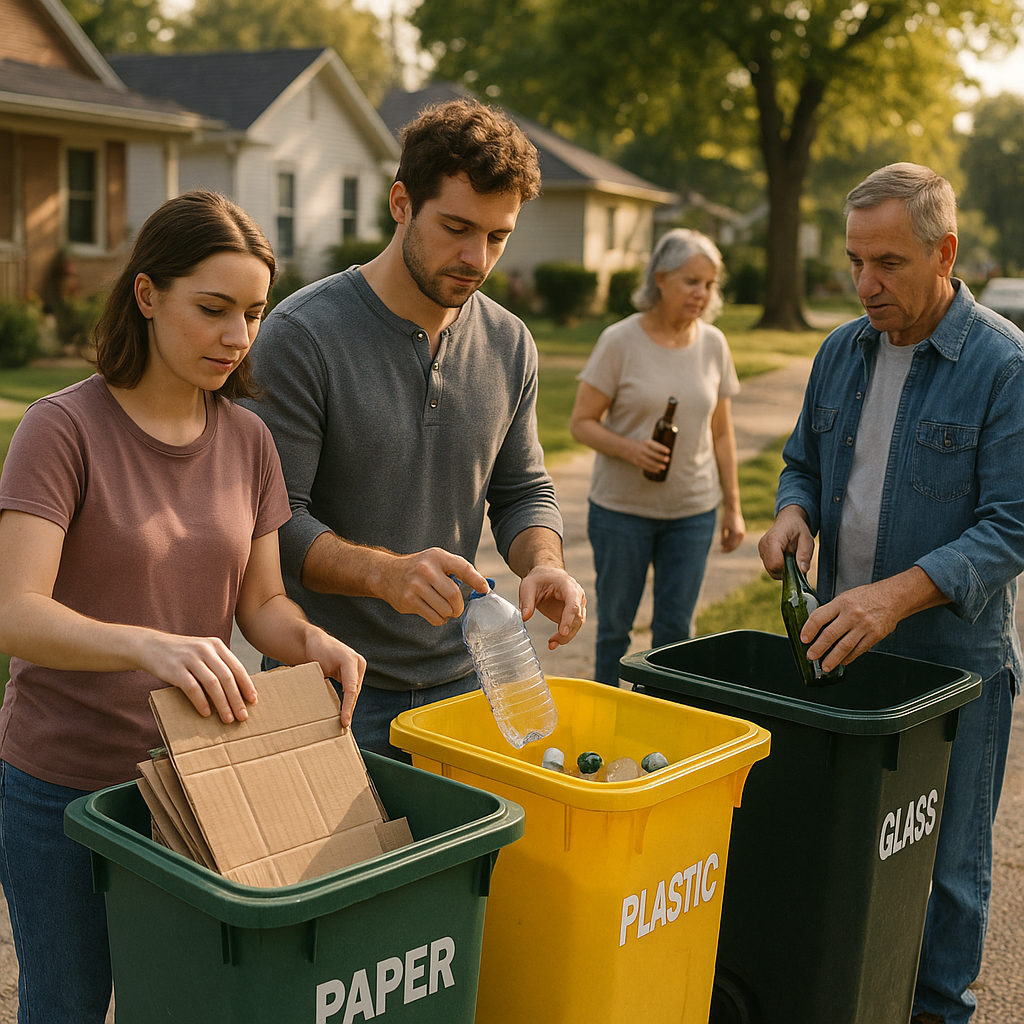5901 Botham Jean Blvd, Dallas, TX 75215
Understanding Pre-Consumer vs. Post-Consumer Waste
July 24, 2025Every product we use generates waste at various points in its lifecycle. Understanding these points helps us make informed recycling decisions. The two main categories of waste in our recycling system are pre-consumer and post-consumer waste, representing distinct stages in a product’s journey.
Pre-consumer waste refers to materials discarded before reaching consumers. It typically occurs during manufacturing and includes scraps, trimmings, and rejected materials that don’t meet quality standards. For example, in a paper mill, trimmed paper edges and defective pages become pre-consumer waste. Manufacturers often recognize the value in this material, reusing it internally or selling it to other industries.
Post-consumer waste is produced by consumers after a product has served its purpose. This includes everyday items like empty plastic bottles, food packaging, worn-out clothing, and used paper products. These materials have completed their consumer lifecycle and need proper disposal or recycling to avoid ending up in landfills. Unlike pre-consumer waste, post-consumer waste poses more challenges in the recycling stream because it is often mixed with other materials and may be contaminated.
How is pre-consumer waste handled?

Pre-consumer waste is often reintegrated into manufacturing processes through efficient collection and recycling systems. This type of waste includes materials generated before products reach consumers, such as trimmings, defective items, and excess materials from production lines. Many manufacturing facilities have implemented comprehensive internal recycling programs to capture this valuable resource stream.
In the textile industry, pre-consumer recycling is standard practice. Fabric scraps and cuttings from garment production are collected and processed into new fibers or materials. For example, a t-shirt manufacturer might collect cotton trimmings from pattern cutting and send these scraps to be shredded and respun into new yarn for future products. This process conserves raw materials and reduces the environmental impact of textile production.
Metal manufacturing demonstrates strong pre-consumer recycling practices. Metal shavings from machining operations are typically collected, sorted by type, and melted down for reuse. A single automotive parts factory can reclaim tons of aluminum or steel scrap monthly, significantly reducing the need for virgin metal extraction.
Companies handle pre-consumer waste in various ways, depending on material type and volume. Some businesses have established closed-loop systems where waste is processed and used internally. Others partner with specialized recycling companies that collect, process, and transform manufacturing scraps into usable raw materials. Plastic injection molding facilities, for instance, often grind sprues and runners (excess plastic from the molding process) and immediately reincorporate this material into new production runs.
The economic benefits of pre-consumer waste recycling are substantial. By reclaiming materials that would otherwise be discarded, companies reduce disposal costs while decreasing expenses for new raw materials. Additionally, businesses that effectively manage pre-consumer waste often gain competitive advantages through improved sustainability metrics and regulatory compliance.
Beyond textiles and metals, pre-consumer recycling extends to numerous industries. Paper mills recycle trimmings and off-spec rolls. Food processors repurpose by-products. Electronics manufacturers reclaim precious metals from rejected circuit boards. These practices are critical steps toward more circular manufacturing models where waste is minimized and materials maintain their value through multiple lifecycles.
Source reduction strategies complement recycling efforts by minimizing pre-consumer waste generation from the outset. Design improvements, process optimization, and better quality control can substantially reduce the volume of scraps and defective products. Combined with robust recycling programs, these approaches create more sustainable manufacturing systems with significantly reduced environmental footprints.
What are the characteristics of post-consumer waste?

Post-consumer waste refers to materials that have completed their lifecycle with consumers before entering the waste stream. Unlike pre-consumer waste, which consists of manufacturing scraps that never reached consumers, post-consumer waste has served its intended purpose and been discarded by end-users. These materials typically require more extensive processing before they can be recycled.
The most defining characteristic of post-consumer waste is its origin—it comes directly from consumer use. This includes everyday household items such as empty plastic bottles, food packaging, newspapers, and aluminum cans that have been used and then disposed of through residential waste collection systems. Larger items like appliances, furniture, and electronic devices that have reached the end of their useful life are also part of post-consumer waste.
Another key characteristic is contamination. Post-consumer waste often contains food residue, mixed materials, and other contaminants that complicate the recycling process. For example, a pizza box stained with grease or a plastic container with food remnants requires additional cleaning and sorting before the materials can be recovered. This contamination is why post-consumer waste typically demands more intensive processing than pre-consumer waste.
Post-consumer waste varies significantly in composition. It includes paper and cardboard products (43% of the recycling stream in many communities), plastics of various types, glass containers, metal packaging, textiles, and electronic components. This diversity creates challenges for efficient recycling, as each material type requires different handling procedures.
The environmental value of diverting post-consumer waste is substantial. When these materials are recycled rather than sent to landfills, they help prevent greenhouse gas emissions, reduce the need for raw material extraction, and conserve energy. For instance, recycling just ten plastic bottles can save enough energy to power a laptop for more than 25 hours. This is why products made with post-consumer recycled content are generally considered more environmentally beneficial than those made with pre-consumer recycled content.
Municipal solid waste management systems are increasingly focused on improving post-consumer waste diversion rates through better collection methods, consumer education, and advanced sorting technologies. These efforts aim to capture more value from materials that would otherwise occupy landfill space and generate methane emissions as they decompose.
| Material | Common Example | Challenges | Recyclability |
| Plastics | Plastic bottles | Contamination with food residues | Recyclable often into lower quality products |
| Paper | Newspapers | Contaminated with grease or food residues | High, often recycled back into paper products |
| Glass | Glass containers | Mixed colors can complicate processing | Recyclable into new glass containers |
| Metals | Aluminum cans | Usually less contaminated | Highly recyclable, retains quality |
| Textiles | Clothing | Mixed fibers make recycling complex | Often downcycled into cleaning rags |
| Electronics | Old phones | Complex disassembly needed for valuable materials | Recyclable for components |
Despite the challenges in processing post-consumer waste, its successful diversion from landfills represents a significant opportunity for environmental conservation and resource recovery in the circular economy. When consumers participate in recycling programs and manufacturers incorporate post-consumer materials into new products, they complete an important loop in sustainable materials management.
Which Type of Recycled Content Is Preferable?

Post-consumer recycled content is generally considered more sustainable than pre-consumer recycled content due to its direct environmental impact. These materials have completed their intended lifecycle with consumers and would likely end up in landfills without recycling initiatives. Capturing these materials helps prevent waste accumulation and reduces landfill expansion.
Pre-consumer recycled content, while still environmentally beneficial, has a less significant impact. These materials, consisting of manufacturing scraps, trimmings, and rejected products, have never reached consumers. Manufacturers have long had economic incentives to capture and reuse these materials instead of discarding them, making their recycling less transformative from an environmental standpoint.
The preference for post-consumer content is reflected in regulatory developments. Several states have passed legislation specifically requiring post-consumer recycled content in certain products. California, for instance, is considering amendments to its plastic bag ban that would require paper bags to contain 100% post-consumer recycled content. New Jersey has implemented minimum recycled content requirements for containers and packaging products sold in the state.
From a circular economy perspective, post-consumer recycling completes a loop. It encourages sustainable consumer behavior, stimulates market demand for recycled materials, creates jobs in the recycling sector, and helps keep recycling operations domestic rather than shipping waste overseas. These benefits extend beyond the direct environmental impact of waste diversion.
Both types of recycled content share important environmental benefits:
- Reduced demand for virgin materials
- Conservation of natural resources
- Lower energy consumption in production
- Decreased greenhouse gas emissions
- Minimized habitat destruction from resource extraction
When choosing products, look for those containing recycled content—particularly those with high percentages of post-consumer material. However, remember that product quality remains essential. A poorly made product with recycled content that quickly fails and requires replacement may ultimately create more waste than a durable product with less recycled content.
For businesses implementing sustainability initiatives, incorporating both types of recycled content can demonstrate environmental commitment while meeting different product requirements. Pre-consumer content often maintains higher purity levels due to its controlled collection environment, making it suitable for applications with stringent quality standards.
| Aspect | Pre-Consumer Recycled Content | Post-Consumer Recycled Content |
|---|---|---|
| Definition | Materials reclaimed during the manufacturing process before reaching consumers. | Materials used and discarded by consumers, then reclaimed. |
| Source | Manufacturing scraps, trimmings, and rejects. | Used consumer items like plastic bottles, newspapers, and cans. |
| Environmental Impact | Reduces new raw material usage, but less impactful as manufacturers already reuse these materials. | Greater impact due to direct diversion from landfills, reducing landfill expansion and greenhouse gas emissions. |
| Recyclability Challenges | Typically less contaminated and easier to recycle. | Often contaminated, requiring extensive processing and sorting. |
| Examples | Textile cuttings, metal shavings. | Plastic bottles, paper products, aluminum cans. |
How Do Consumers Influence Recycled Content Success?

Consumer behavior is crucial in determining the success of recycled content initiatives. While manufacturers and policymakers set recycling system frameworks, consumer participation is what truly drives the circular economy. From properly sorting recyclables to making informed purchasing decisions, individuals influence both the supply of recyclable materials and the demand for recycled-content products.
One key area of influence is the quality of post-consumer recycling streams. When consumers rinse containers, separate recyclables correctly, and avoid contaminating bins with non-recyclable items, they significantly enhance the chances of effective recovery and reuse. Education campaigns, clear labeling, and convenient recycling facilities are vital to support these habits on a large scale.
Purchasing behavior also shapes market demand. Consumers who actively seek products made with recycled content—especially post-consumer recycled (PCR) materials—encourage manufacturers to invest in sustainable production. Labels indicating recycled content help guide these choices. For example, selecting packaging labeled as “made with 50% PCR plastic” supports the market for reclaimed materials and reduces reliance on virgin inputs.
Public awareness of environmental impacts has compelled many companies to adopt transparent sustainability reporting and set goals for incorporating more recycled content. Consumers can bolster these efforts by supporting responsible brands and pressuring lagging companies through purchasing decisions or feedback.
An informed and engaged public is essential to the success of recycling systems. By consistently recycling correctly and choosing recycled-content products, consumers help close the loop and build more resilient, resource-efficient economies.
Conclusion

Understanding the distinction between pre-consumer and post-consumer waste is critical for advancing sustainable practices. While both types of recycled content offer environmental benefits, post-consumer materials play a more impactful role in waste diversion and resource recovery. Success depends on a holistic effort—manufacturers designing for recyclability, governments setting supportive policies, and consumers making informed decisions. When all actors work together, we can achieve a circular economy where materials retain value throughout their lifecycle.
Call Okon Recycling at 214-717-4083 to explore recycling solutions that support your sustainability goals.
